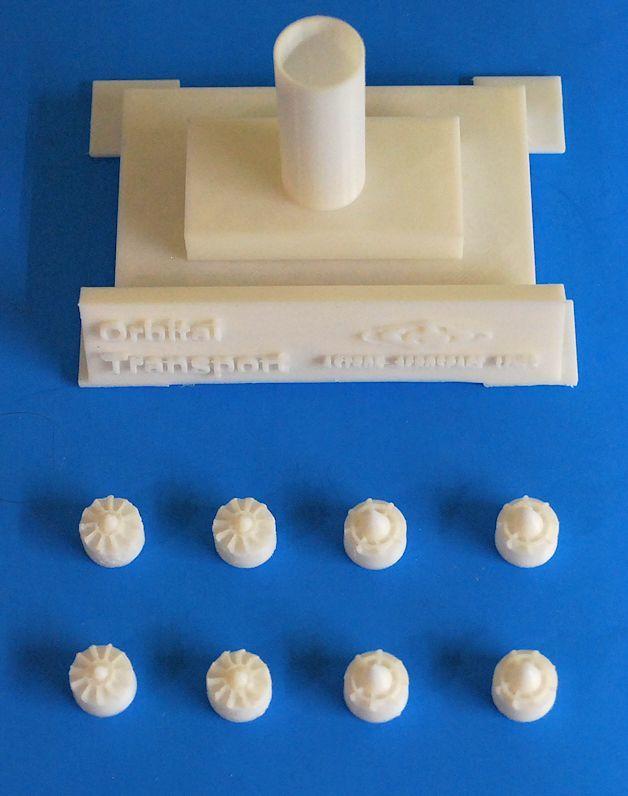Orbital Transport Accessory Kit
** Estes Orbital Transport Accessory Kit ==============================**
The original Orbital Transport was released in 1969 and has been a favorite among rocketeers of all ages for years. In 2002 it was re-released for one year run. Despite the age of the design it is one that many rocketeers still return to and continue to build, either through the purchase of the original kits or by using plans from the original design.
This “Accessory Kit” adds several things to the original design. The first is a stand specifically for the model. The name plate not only identifies the model, but carries the logo for “Astron Aerospace Lines,” the company named on the model. The kit also includes a jet intake and exhaust.
Intake and ExhaustThese pieces are designed to go into the ‘scramjet tubes’ that are located under the wing of the booster stage of the rocket. The original kit utilized four BT-5 tubes that have nothing in them. When the model is on display it just doesn’t appear “realistic” being able to look through the tubes. These intake and exhaust pieces add a ‘scale’ look to the model. You will need to make four of each piece, as an intake and exhaust are placed in each tube.
Once the intake and exhaust have printed, you will likely need to sand down the printed pieces as well as the inside of the scramjet tubes to get everything to fit. On our original model, we painted the intake and exhaust faces black, and then highlighted the fins and blades with silver paint. We recommend that you paint the rocket and the printed pieces prior to inserting them into the tubes.
To add the pieces to the model, begin with the intakes. Insert them from the rear of the tubes and push them forward until they are even with the forward end of the tube. Using a small piece of scrap wood, enter from the rear of the tube and apply some plastic cement around the intake piece to hold it in place. Do this for each intake.
Next take your scrap wood and add a line of plastic cement about *** from the rear of the inside of the tube. Insert the exhaust pieces from the rear until the tip of the cone is even with the end of the tube. Do this for each exhaust. Allow these to dry completely.
Display StandThe display stand consist of a square base with an 18mm diameter tube on top. The booster is slid onto this tube to hold everything in place. The front of the stand has a slightly tilted nameplate. The nameplate was painted red using Krylon spray paint, while the rest of the stand was left white.
To get the letters back to white you can either paint them (which is what I did) or use paint thinner to remove the red. Place a small amount of thinner on a rag to wipe and then carefully wipe the paint off. The "Astron" logo was painted yellow.
The last photo shows the completed model on the stand. Unfortunately, the decals that came in this kit are nearly 20 years old and didn't hold up well. Next step is to print out some new decals and apply them to finish the rocket.
Additional InformationThe plans for the original Orbital Transport can be found at http://www.spacemodeling.org/jimz/k-42.htm.
Austin Aerospace Educational Network Web Site: https://rocketryjournal.wordpress.com/ Flight Logs Database: https://sourceforge.net/projects/flight-log/
Model originally uploaded to Thingiverse at https://www.thingiverse.com/thing:4720811.






